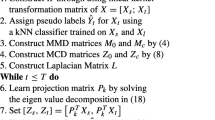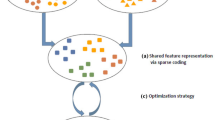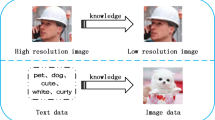Abstract
Heterogeneous domain adaptation is a challenging problem due to the fact that it requires generalizing a learning model across training data and testing data with different distributions and features. To alleviate the difficulty of this task, most researchers usually perform some data preprocessing operations. However, such operations may lead to the loss of shareable information before domain adaptation. Moreover, most current work neglects the structural information between data, which is crucial for classification. To overcome the limitations mentioned above, we propose a novel algorithm, named as heterogeneous discriminative features learning and label propagation (HDL), which includes i) features learning with label consistency through two domain-specific projections, and ii) label propagation through exploiting structural information of data. Notably, each of the two sides reinforces each other. For each objective function, the corresponding analytical solutions are presented. Comprehensive experimental evidence on a large number of text categorization, image sclassification and text to image recognition datasets verifies the effectiveness and efficiency of the proposed approach over several state-of-the-art methods.




Similar content being viewed by others
References
Asaei A, Cernak M, Bourlard H (2017) Perceptual Information Loss due to Impaired Speech Production. IEEE/ACM Trans Audio Speech Lang Process (TASLP) 25(12):2433–2443
Audhkhasi K, Kingsbury B, Ramabhadran B, Saon G, Picheny M (2018) Building competitive direct acoustics-to-word models for english conversational speech recognition. International Conference on Acoustics, Speech and Signal Processing (ICASSP), pp 4759–4763
Bay H, Tuytelaars T, Van Gool L (2006) Surf: Speeded up robust features. In European conference on computer vision. In: European conference on computer vision, pp 404–417
Chen WY, Hsu TMH, Tsai YHH, Wang YCF, Chen MS (2016) Transfer neural trees for heterogeneous domain adaptation. In: European Conference on Computer Vision, pp 399–414
Chen X, Monfort M, Liu A, Ziebart BD (2016) Robust covariate shift regression. In: Artificial Intelligence and Statistics, pp 1270–1279
Chen X, Kundu K, Zhu Y, Ma H, Fidler S, Urtasun R (2018) 3d object proposals using stereo imagery for accurate object class detection. IEEE Trans Pattern Anal Mach Intell 40(5):1259–1272
Cheng G, Han J, Zhou P, Xu D (2019) Learning rotation-invariant and fisher discriminative convolutional neural networks for object detection. IEEE Trans Image Process 28(1):265–278
Courty N, Flamary R, Habrard A, Rakotomamonjy A (2017) Joint distribution optimal transportation for domain adaptation. In: Advances in Neural Information Processing Systems, pp 3730–3739
Dai W, Chen Y, Xue GR, Yang Q, Yu Y (2009) Translated learning: Transfer learning across different feature spaces. In: Advances in neural information processing systems, pp 353–360
Donahue J, Jia Y, Vinyals O, Hoffman J, Zhang N, Tzeng E, Darrell T (2014) Decaf: A deep convolutional activation feature for generic visual recognition. In: International conference on machine learning, pp 647–655
Friedjungová M, Jiřina M (2017) An overview of transfer learning focused on asymmetric heterogeneous approaches. In: International Conference on Data Management Technologies and Applications, pp 3–26
Friedjungová M, Jiřina M (2017) Asymmetric Heterogeneous Transfer Learning: A Survey. In: DATA, pp 17–27
Gong B, Shi Y, Sha F, Grauman K (2012) Geodesic flow kernel for unsupervised domain adaptation. In: IEEE Conference on Computer Vision and Pattern Recognition, pp 2066–2073
He K, Zhang X, Ren S, Sun J (2016) Deep residual learning for image recognition. In: Proceedings of the IEEE conference on computer vision and pattern recognition, pp 770–778
Hoffman J, Rodner E, Donahue J, Darrell T, Saenko K (2013) Efficient Learning of Domain-Invariant Image Representations. International Conference on Learning Representation 1, 2, 3, 6, 8
Hoffman J, Rodner E, Donahue J, Darrell T, Saenko K (2014) Asymmetric And Category Invariant Feature Transformations for Domain Adaptation. Int J Comput Vis 109(1-2):28–41
Hubert Tsai YH, Yeh YR, Frank Wang YC (2016) Learning cross-domain landmarks for heterogeneous domain adaptation. In: Proceedings of the IEEE conference on computer vision and pattern recognition, pp 5081–5090
Johnson R, Zhang T (2015) Semi-supervised convolutional neural networks for text categorization via region embedding. Adv Neural Inf Process Syst 5:919—927
Kurmi VK, Kumar S, Namboodiri VP (2019) Attending to Discriminative Certainty for Domain Adaptation. In: Proceedings of the IEEE Conference on Computer Vision and Pattern Recognition, pp 491–500
Lawrence S, Giles CL (2000) Overfitting and neural networks: conjugate gradient and backpropagation. In: Proceedings of the IEEE-INNS-ENNS International Joint Conference on Neural Networks. IJCNN 2000. Neural Computing: New Challenges and Perspectives for the New Millennium, vol 1, pp 114–119
Li W, Duan L, Xu D, Tsang IW (2014) Learning with augmented features for supervised and semi-supervised heterogeneous domain adaptation. IEEE Trans Pattern Anal Mach Intell 36(6):1134–1148
Li J, Lu K, Huang Z, Zhu L, Shen HT (2018) Heterogeneous domain adaptation through progressive alignment. IEEE Trans Neural Netw Learn Syst 30 (5):1381–1391
Li J, Lu K, Huang Z, Zhu L, Shen HT (2018) Transfer independently together: A generalized framework for domain adaptation. IEEE transactions on cybernetics (99):1–12
Li H, Pan SJ, Wang S, Kot AC (2019) Heterogeneous Domain Adaptation via Nonlinear Matrix Factorization. IEEE transactions on neural networks and learning systems
Liu H, Shao M, Ding Z, Fu Y (2019) Structure-preserved unsupervised domain adaptation. IEEE Trans Knowl Data Eng 31(4):799–812
Long M, Wang J, Ding G, Sun J, Yu PS (2014) Transfer feature learning with joint distribution adaptation. In: Proceedings of the IEEE international conference on computer vision, vol 5, pp 2200–2207
Long M, Zhu H, Wang J, Jordan MI (2016) Unsupervised domain adaptation with residual transfer networks. In: Advances in Neural Information Processing Systems, pp 136–144
Lu H, Shen C, Cao Z, Xiao Y, van den Hengel A (2018) An embarrassingly simple approach to visual domain adaptation. IEEE Trans Image Process 27(7):3403–3417
Luo Y, Wen Y, Tao D (2018) Heterogeneous multitask metric learning across multiple domains. J Second Ref 29(9):4051–4064
Ma L, Crawford MM, Zhu L, Liu Y (2018) Centroid and Covariance Alignment-Based Domain Adaptation for Unsupervised Classification of Remote Sensing Images. IEEE Transactions on Geoscience and Remote Sensing. https://doi.org/10.1109/TGRS.2018.2872850
Pan SJ, Yang Q (2010) A survey on transfer learning. IEEE Trans Knowl Data Eng 22(10):1345–1359
Pan SJ, Tsang IW, Kwok JT, Yang Q (2011) Domain adaptation via transfer component analysis. IEEE Trans Neural Netw 22(2):199–210
Prettenhofer P, Stein B (2010) Cross-language text classification using structural correspondence learning. In: Proceedings of the 48th annual meeting of the association for computational linguistics, pp 1118–1127
Rozantsev A, Salzmann M, Fua P (2019) Beyond sharing weights for deep domain adaptation. IEEE Trans Pattern Anal Mach Intell 41(4):801–814
Sankaranarayanan S, Balaji Y, Castillo CD, Chellappa R (2018) Generate to adapt: Aligning domains using generative adversarial networks. In: Proceedings of the IEEE Conference on Computer Vision and Pattern Recognition, pp 8503–8512
Shi X, Liu Q, Fan W, Philip SY, Zhu R (2010) Transfer learning on heterogenous feature spaces via spectral transformation. In: 2010 IEEE international conference on data mining, pp 1049–1054
Srivastava N, Hinton G, Krizhevsky A, Sutskever I, Salakhutdinov R (2014) Dropout: a simple way to prevent neural networks from overfitting. J Mach Learn Res 15(1):1929–1958
Tang B, He H, Baggenstoss PM, Kay S (2016) A Bayesian classification approach using class-specific features for text categorization. IEEE Trans Knowl Data Eng 28(6):1602–1606
Tzeng E, Hoffman J, Saenko K, Darrell T (2017) Adversarial discriminative domain adaptation. In: Proceedings of the IEEE Conference on Computer Vision and Pattern Recognition, pp 7167–7176
Vidovic MMC, Hwang HJ, Amsüss S, Hahne JM, Farina D, Müller KR (2016) Improving the robustness of myoelectric pattern recognition for upper limb prostheses by covariate shift adaptation. IEEE Trans Neural Syst Rehab Eng 24(9):961–970
Wang C, Mahadevan S (2011) Heterogeneous domain adaptation using manifold alignment. In: Twenty-Second International Joint Conference on Artificial Intelligence. https://doi.org/10.5591/978-1-57735-516-8/IJCAI11-259
Wen J, Yu CN, Greiner R (2014) Robust Learning under Uncertain Test Distributions: Relating Covariate Shift to Model Misspecification. In: International Conference on Machine Learning, pp 631–639
Wold S, Sbensen K, Geladi P (1987) Principal component analysis. Chem Intell Lab Syst , vol 2, pp 37–52
Xiao M, Guo Y (2013) A novel two-step method for cross language representation learning. In: Advances in Neural Information Processing Systems, pp 1259–1267
Yao Y, Zhang Y, Li X, Ye Y (2019) Heterogeneous Domain Adaptation via Soft Transfer Network. arXiv:1908.10552
Yeh YR, Huang CH, Wang YCF (2014) Heterogeneous domain adaptation and classification by exploiting the correlation subspace. IEEE Trans Image Process 23(5):2009–2018
Zhou JT, Tsang IW, Pan SJ, Tan M (2014) Heterogeneous domain adaptation for multiple classes. In: Artificial Intelligence and Statistics, pp 1095–1103
Zhou JT, Pan SJ, Tsang IW, Ho SS (2016) Transfer learning for cross-language text categorization through active correspondences construction. In: Thirtieth AAAI Conference on Artificial Intelligence
Zhu X, Ghahramani Z (2002) Learning from labeled and unlabeled data with label propagation. Technical Report CMU-CALD-02-107, Carnegie Mellon University
Acknowledgments
The work is supported by National Key R&D Program of China (2018YFC0309400), National Natural Science Foundation of China (61871188), Guangzhou city science and technology research projects (201902020008).
Author information
Authors and Affiliations
Corresponding author
Additional information
Publisher’s note
Springer Nature remains neutral with regard to jurisdictional claims in published maps and institutional affiliations.
Rights and permissions
About this article
Cite this article
Huang, J., Zhou, Z., Shang, J. et al. Heterogeneous domain adaptation with label and structural consistency. Multimed Tools Appl 79, 17923–17943 (2020). https://doi.org/10.1007/s11042-020-08731-x
Received:
Revised:
Accepted:
Published:
Issue Date:
DOI: https://doi.org/10.1007/s11042-020-08731-x




